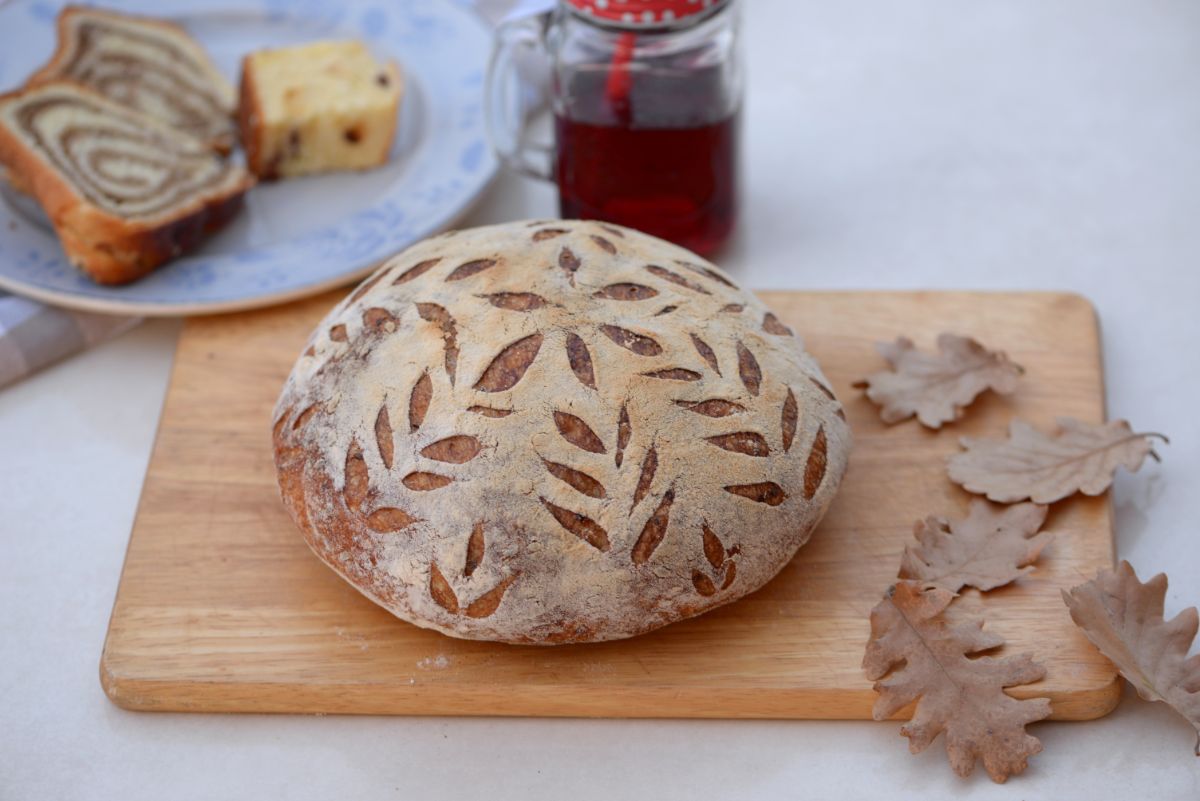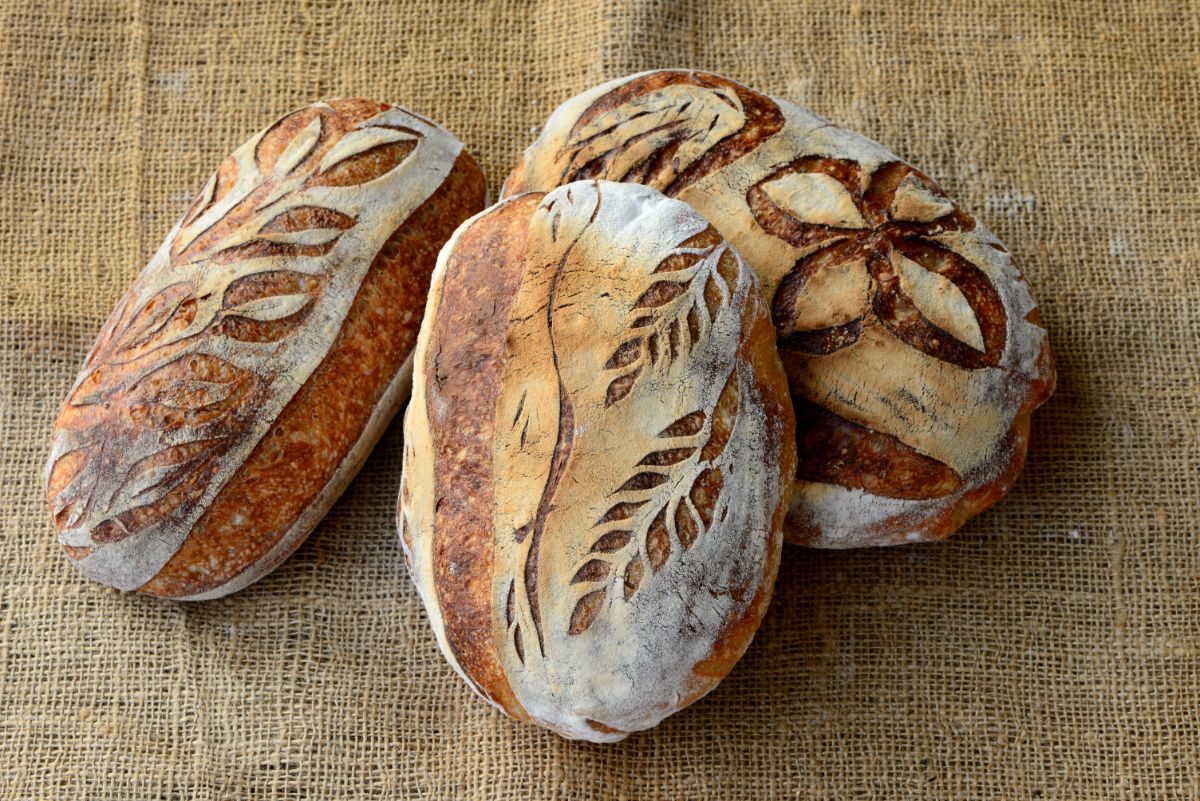A loaf of bread is scored by running a sharp knife through the dough so it can expand during the baking process.
So, what is the purpose of scoring bread? Scoring is done mainly to control which direction the bread will expand through the oven spring. It will also help the gases inside the bread to go out without breaking the bread.

When a baker scores their loaf, it is done with confidence and without hesitation. As you bake more bread, you will learn scoring is not as simple as it sounds. It took me some time to master this and yet I’m still not a pro.
If you want to see what kind of scoring lame I’m using you can go and check this article: Best Bread Scoring Lames
Why Should Bread Be Scored?
The process of scoring is the cuts made in a loaf before it is baked. Not all bread is scored, such as those that are baked in a pan generally, do not have scoring.
Scoring is done mostly on breads that are considered ‘free form’ or ‘hearth’ bread. The process is done just before the loaf is put into the oven. French breads are often scored as soon as they are formed, and before the proofing.
The scoring will create a weak spot on the top of the loaf to stop it from bursting. It will also control how the bread expands during the ‘oven spring.’
- Oven spring is the last burst of rising in a loaf of bread and happens just after it is placed in the oven. The oven spring will occur before the crust begins to harden. The oven spring will tell the crumb texture of the bread. The more oven spring that happens means you will have an airy, light interior in the loaf, and a little oven spring tells the bread will be denser with a compacted crumb.
How deep should you slash the bread, the angle at which the score is made, and the pattern you use will all influence how the loaf will expand and how the ‘ear’ will form.
- An ear on a scored loaf of bread is sometimes called the gringe and is an opening in the bread or bloom. The ear is an overhanging of crust and is formed by correctly shaping, kneading, mixing, fermenting, scoring, baking, or steaming the bread dough. To make the ‘ear,’ you use a sharp knife and make the cut at a small angle to the loaf. The cut should be only ¼ inch deep. By making this shallow cut, you create a flap lifting up. A deep cut will not create this flap. The flap that is created by this form of cut is referred to as an ‘ear.’
When a loaf of bread is scored, the pattern you choose can make a pleasing visual on the top of your bread. There are many patterns to choose from if you check what others have used on baguettes. Some bakers use a special scoring to identify the bread they’ve baked or to create their own unique signature.
Tips for Successful Scoring

The first tip in successful scoring is to use a very sharp knife. Use the knife to make confident and swift slashes while being gentle. You want to let the knife doing the work of scoring and not press down on the dough with any pressure.
It may help to wet the knife blade between the slashes, especially if your dough is sticky. Some bakers like to create what is called an ‘ear’ with their scoring.
To make the ‘ear,’ you hold the knife blade at a slight angle (around 30 degrees) to the surface of the loaf and cut about ¼ inch deep. The real skill of scoring comes with lots of practice.
Other tips for successful scoring include spraying your knife with oil or cooking spray before you start. This tip will make the scoring a bit easier through your dough. You can also draw a pattern on a sheet of paper before you try to apply it to your bread dough.
Some scoring is completed with a straight blade. Many bakers prefer the straight blade when they make cuts perpendicular to the top of the dough. This cut is mostly used for round-shaped bread.
A curved blade will work better on other shapes, such as the long-shaped loaves. Scoring on a long-shaped bread is normally done parallel to the long sides of the loaf.
The scoring stroke should be decisive, smooth, firm, and quick. If you are trying to score for the first time, you might find it helpful to perform a few practice swings to get the idea of what movements are involved.
Being able to visualize your movements before making the real cuts can help with your first attempts of scoring.
The scoring cuts should be from ¼ to ½ inches deep. If your dough is sticky or wet-like, your scoring should be more shallow than what a dryer loaf needs.
How Scoring Effects a Bread
Scoring is not just leaving a signature or identifying a specific variety of bread, and it is not just making a pretty design for your bread. Scoring is done for a reason as indicated; to control the direction the loaf will expand.
Scoring impacts the shape of your bread, how high it will bake, and for some varieties whether or not it will stay round or become oblong.
An example of scoring for long-shaped loaves should be in the direction of the long side of the loaf. By scoring a long-shaped bread somewhat parallel to its side will promote sideways expansion.
If you are baking bread with high rye content, you want to encourage a higher rise in the loaf, so you achieve a rounder crosscut. Boules can be scored in different patterns to create different effects on how it will expand.
A common score for this bread is a tic-tac-toe pattern, which will direct the expansion up. If you use a more complicated scoring like the diamond-shape, you will get a flatter loaf of bread.
Another way to score Boule is to make multiple parallel cuts to encourage expansion at a right angle. Diamond-shaped scoring will make your Boule more oblong in shape.
Most of these tips have focused on how to score, but other steps in your bread baking process impact how the cuts will look on a finished loaf.
All steps are taken from your ingredients and how much of them you use to your directions on how you work those ingredients, and all the way to how you steam your oven will have a role in how your cuts will open.
